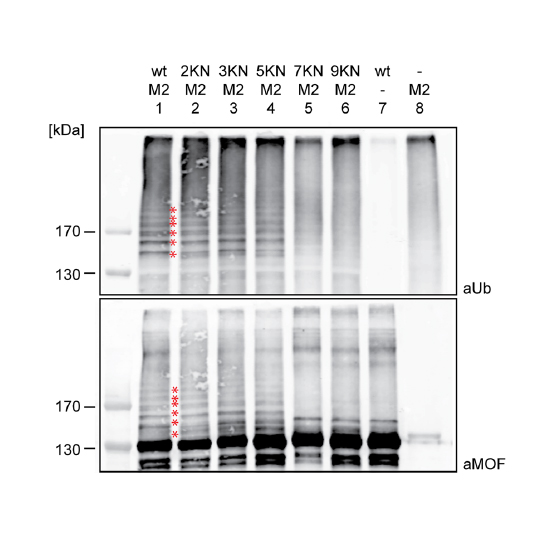Ubiquitylation of the acetyltransferase MOF in Drosophila melanogaster
16-May-2017
PLoS ONE 12(5): e0177408. https://doi.org/10.1371/journal.pone.0177408
PLOS ONE, online article
The nuclear acetyltransferase MOF (KAT8 in mammals) is a subunit of at least two multi-component complexes involved in transcription regulation. In the context of complexes of the ‘Non-Specific-Lethal’ (NSL) type it controls transcription initiation of many nuclear housekeeping genes and of mitochondrial genes. While this function is conserved in metazoans, MOF has an additional, specific function in Drosophila in the context of dosage compensation. As a subunit of the male-specific-lethal dosage compensation complex (MSL-DCC) it contributes to the doubling of transcription output from the single male X chromosome by acetylating histone H4. Proper dosage compensation requires finely tuned levels of MSL-DCC and an appropriate distribution of MOF between the regulatory complexes. The amounts of DCC formed depends directly on the levels of the male-specific MSL2, which orchestrates the assembly of the DCC, including MOF recruitment. We found earlier that MSL2 is an E3 ligase that ubiquitylates most MSL proteins, including MOF, suggesting that ubiquitylation may contribute to a quality control of MOF’s overall levels and folding state as well as its partitioning between the complex entities. We now used mass spectrometry to map the lysines in MOF that are ubiquitylated by MSL2 in vitro and identified in vivo ubiquitylation sites of MOF in male and female cells. MSL2-specific ubiquitylation in vivo could not be traced due to the dominance of other, sex-independent ubiquitylation events and conceivably may be rare or transient. Expressing appropriately mutated MOF derivatives we assessed the importance of the ubiquitylated lysines for dosage compensation by monitoring DCC formation and X chromosome targeting in cultured cells, and by genetic complementation of the male-specific-lethal mof2 allele in flies. Our study provides a comprehensive analysis of MOF ubiquitylation as a reference for future studies.











